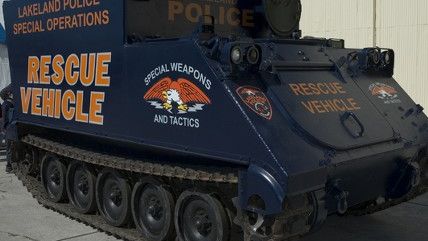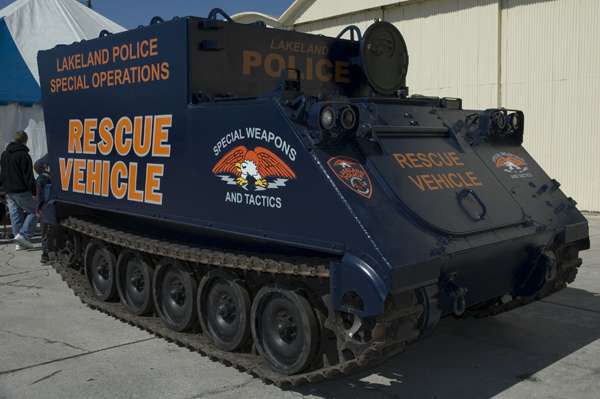Will San Bernardino Shootings Lead to More Militarized Police?
SWAT team's heroic response to mass shooting leads to calls for more military gear for local cops.

The image of the "Warrior Cop," personified by SWAT teams and local law

enforcement agencies rolling through town in MRAPs, body armor and other military accoutrements, has taken a bit of a public relations-beating over the past couple of years.
Images of toddlers blown up by flash-bang grenades, innocent people shot dead during no-knock raids, and the heavy-handed response to the protests in Ferguson during the summer of 2014 have all added to the increased scrutiny of the militarization of police.
But a SWAT team's heroic response to the San Bernardino shootings has helped bring "Special Weapons and Tactics" back in vogue, with some calls for President Obama to remove the limitations on the Pentagon's 1033 program he imposed back in May.
Allegra Kirkland wrote at Talking Points Memo:
Within hours, police officers, columnists and cable news pundits began pointing to the San Bernardino shooting as proof of why local law enforcement agencies require military gear and training. They argued that depriving law enforcement of equipment like armored personnel carriers in the post-Ferguson era endangers the lives of officers and civilians alike.
Fox News host Gretchen Carlson and CNN law enforcement analyst Tom Fuentes separately chastised the Obama administration for prohibiting the transfer of some surplus military equipment to local police forces.
"We make much about the militarization of the police," Fuentes said Wednesday on CNN's "The Situation Room." "That's because we have a militarized public in the country with military-assault rifles, armored vests, bullets that pierce armors. That's one of the situations our police often go up against—this type of armament in the citizenry of our country."
Mind you, Obama's order only prevented local police forces from acquiring "grenade launchers, tracked armored vehicles, armed aircraft, bayonets, and guns and ammunition of .50 caliber or higher," but still permitted them take in "wheeled armored vehicles, drones, helicopters, firearms and riot gear," all at no cost to them through the Department of Defense's 1033 program.
According to the Marshall Project:
The program has doled out $5 billion in equipment since 1990. Most of it was general office and maintenance equipment – shovels, copiers, computers – but the Pentagon largesse included tactical military equipment worth more than $1.4 billion, disseminated in 203,000 transfers to about 7,500 agencies.
In San Bernardino, like the rest of the country, SWAT teams rarely (if ever) encounter mass shooters or terrorists. Until the shootings two weeks ago, San Bernardino's SWAT teams were far-better known to be deployed busting low-level drug dealers, serving warrants, breaking up Hell's Angels clubhouses or raiding medical marijuana dispensaries.
This is not to say there isn't a place for heavily-armed and armored high-risk response teams to neutralize hostage situations or confront mass murderers intent on maximum carnage. But with anywhere from 50,000-80,000 SWAT raids in the US annually, using the response to the San Bernardino shootings as an excuse to roll back the modest and sensible scale-down of surplus equipment meant for an occupying army would be a mistake.
In 2014, I covered "The Purple Zone Raid," which involved both local and federal agencies using the maximum amount of force possible to raid a smoke shop in tiny Alpine, Texas:


Show Comments (87)